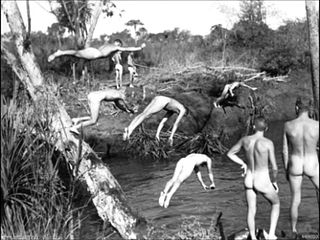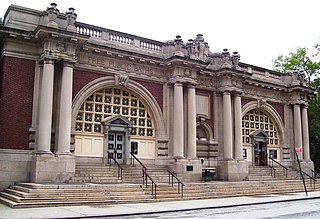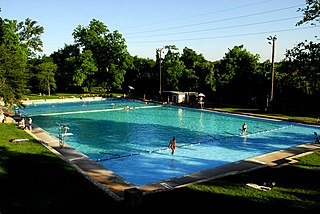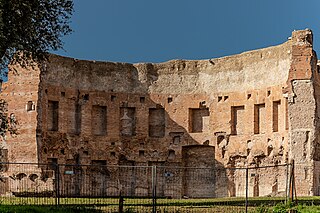
A sauna is a room or building designed as a place to experience dry or wet heat sessions, or an establishment with one or more of these facilities. The steam and high heat make the bathers perspire. A thermometer in a sauna is typically used to measure temperature; a hygrometer can be used to measure levels of humidity or steam. Infrared therapy is often referred to as a type of sauna, but according to the Finnish sauna organisations, infrared is not a sauna.

Hygiene is a set of practices performed to preserve health. According to the World Health Organization (WHO), "Hygiene refers to conditions and practices that help to maintain health and prevent the spread of diseases." Personal hygiene refers to maintaining the body's cleanliness. Hygiene activities can be grouped into the following: home and everyday hygiene, personal hygiene, medical hygiene, sleep hygiene, and food hygiene. Home and every day hygiene includes hand washing, respiratory hygiene, food hygiene at home, hygiene in the kitchen, hygiene in the bathroom, laundry hygiene, and medical hygiene at home.

Sentō (銭湯) is a type of Japanese communal bathhouse where customers pay for entrance. Traditionally these bathhouses have been quite utilitarian, with a tall barrier separating the sexes within one large room, a minimum of lined-up faucets on both sides, and a single large bath for the already washed bathers to sit in among others. Since the second half of the 20th century, these communal bathhouses have been decreasing in numbers as more and more Japanese residences now have baths. Some Japanese find social importance in going to public baths, out of the theory that physical proximity/intimacy brings emotional intimacy, which is termed skinship in pseudo-English Japanese. Others go to a sentō because they live in a small housing facility without a private bath or to enjoy bathing in a spacious room and to relax in saunas or jet baths that often accompany new or renovated sentōs.

A shower is a place in which a person bathes under a spray of typically warm or hot water. Indoors, there is a drain in the floor. Most showers have temperature, spray pressure and adjustable showerhead nozzle. The simplest showers have a swivelling nozzle aiming down on the user, while more complex showers have a showerhead connected to a hose that has a mounting bracket. This allows the showerer to hold the showerhead by hand to spray the water onto different parts of their body. A shower can be installed in a small shower stall or bathtub with a plastic shower curtain or door. Showering is common due to the efficiency of using it compared with a bathtub. Its use in hygiene is, therefore, common practice.

Bathing is the act of washing the body, usually with water, or the immersion of the body in water. It may be practiced for personal hygiene, religious ritual or therapeutic purposes. By analogy, especially as a recreational activity, the term is also applied to sun bathing and sea bathing.

A changing room, locker room, or changeroom is a room or area designated for changing one's clothes. Changing-rooms are provided in a semi-public situation to enable people to change clothes with varying degrees of privacy.

Nude swimming is the practice of swimming without clothing, whether in natural bodies of water or in swimming pools. A colloquial term for nude swimming is "skinny dipping".

Public baths originated when most people in population centers did not have access to private bathing facilities. Though termed "public", they have often been restricted according to gender, religious affiliation, personal membership, and other criteria.

A spa is a location where mineral-rich spring water is used to give medicinal baths. Spa towns or spa resorts typically offer various health treatments, which are also known as balneotherapy. The belief in the curative powers of mineral waters goes back to prehistoric times. Such practices have been popular worldwide, but are especially widespread in Europe and Japan. Day spas and medspas are also quite popular, and offer various personal care treatments.

Deep Eddy Pool is a historic man-made swimming pool in Austin, Texas. Deep Eddy is the oldest swimming pool in Texas and features a bathhouse built during the Depression era by the Works Progress Administration. The pool began as a swimming hole in the Colorado River, became a resort in the 1920s, and is today a popular swimming pool operated by the City of Austin.

Bathing played a major part in ancient Roman culture and society. It was one of the most common daily activities and was practised across a wide variety of social classes. Though many contemporary cultures see bathing as a very private activity conducted in the home, bathing in Rome was a communal activity. While the extremely wealthy could afford bathing facilities in their homes, private baths were very uncommon, and most people bathed in the communal baths (thermae). In some ways, these resembled modern-day destination spas as there were facilities for a variety of activities from exercising to sunbathing to swimming and massage.
Vernonia School District 47J v. Acton, 515 U.S. 646 (1995), was a U.S. Supreme Court decision which upheld the constitutionality of random drug testing regimen implemented by the local public schools in Vernonia, Oregon. Under that regimen, student-athletes were required to submit to random drug testing before being allowed to participate in sports. During the season, 10% of all athletes were selected at random for testing. The Supreme Court held that although the tests were searches under the Fourth Amendment, they were reasonable in light of the schools' interest in preventing teenage drug use.

Nudity is the state of being in which a human is without clothing. While estimates vary, for the first 90,000 years of pre-history, anatomically modern humans were naked, having lost their body hair and living in hospitable climates. As humans became behaviorally modern, body adornments such as jewelry, tattoos, body paint and scarification became part of non-verbal communications, indicating a person's social and individual characteristics. Indigenous peoples in warm climates used clothing for decorative, symbolic or ceremonial purposes but were often nude, having neither the need to protect the body from the elements nor any conception of nakedness being shameful. In many societies, both ancient and contemporary, children might be naked until the beginning of puberty. Women may not cover their breasts, being associated with nursing babies more than with sexuality.

Mixed bathing is the sharing of a pool, beach or other place by swimmers of both sexes. Mixed bathing usually refers to swimming or other water-based recreational activities in public or semi-public facilities, such as hotel or holiday resort pool, in a non-sex segregated environment.
François Merry Delabost was a French physician.

Simon Baruch was a physician, scholar, and the foremost advocate of the urban public bathhouse to benefit public health in the United States. He was a medical officer for the Confederate States army and after its defeat, a member of the Ku Klux Klan.

Menstrual hygiene management (MHM) or menstrual health and hygiene (MHH) refers to access to menstrual hygiene products to absorb or collect the flow of blood during menstruation, privacy to change the materials, and access to facilities to dispose of used menstrual management materials. It can also include the "broader systemic factors that link menstruation with health, well-being, gender equality, education, equity, empowerment, and rights". Menstrual hygiene management can be particularly challenging for girls and women in developing countries, where clean water and toilet facilities are often inadequate. Menstrual waste is largely ignored in schools in developing countries, despite it being a significant problem. Menstruation can be a barrier to education for many girls, as a lack of effective sanitary products restricts girls' involvement in educational and social activities.

Nude swimming in US indoor pools was common for men and boys, but rare for women and girls from the late 1880s until the early 1970s. For much of that time period, indoor pool use was primarily for physical education or athletic competition, not recreation. Male nude swimming had been customary in natural bodies of water, which was not viewed as a social problem until the 18th century. When the tradition of skinny-dipping in secluded spots had become more visible with urbanization, indoor pools were first built in the 19th century in part to address this issue by moving male swimming indoors. For the first decades of the 20th century, male nude swimming was associated with a trope of the "old swimming hole" as representing childhood innocence and adult masculinity. In their own classes, nudity was rare for girls based upon an assumption of modesty, but might include young children. Prepubescent boys might be nude in mixed-gender settings, including the presence of female staff, public competitions, and open houses for families.

In contemporary societies, the appropriateness of childhood nudity in various social situations is controversial, with many differences in behavior worldwide. Depending upon conceptions of childhood innocence and sexuality in general, societies may regard social nudity before puberty as normal, as acceptable within same-sex groups, or unacceptable.



















